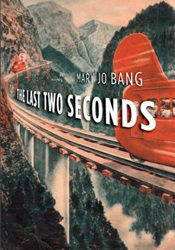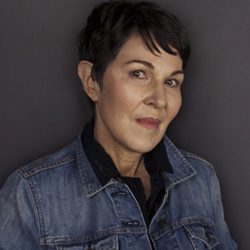
Mary Jo Bang’s latest collection takes up questions of time: what it is, how it works, who it serves, and who it fails. An evocative and ever-shifting book, The Last Two Seconds slides between characters and pronouns, between past and present, between intense interiority and the overwhelming world. It suggests that time as we understand it, in all its irreversible political linearity, fails us. In particular, it is unlivable for women, who are made to live circular lives inside of its straight lines and strict edges: “a window opened out onto a meadow,/ which lead to a river (linear and male), or a lake/(circular and female), whatever you wished.” (67)
The “I” and “she” who variously step in as the collection’s main actors imply and articulate Bang’s major premise – that the self, especially the female self, is constantly changing, oscillating and spiraling. It is aggressively unreliable, reflected in windows and mirrors, made up for cameras and audience observation, shifting so constantly that it can’t be pinned down. It is a palimpsest: “something with something/behind it…a face/in a window at night that essentially said, You see/yourself where you’re not” (39). All reflections beg of their originals, “Who is that? Who was that me?” (39, 12).
This failure is inextricable from time – the self can’t remain consistent across it, can’t retain itself: “The door closed on the self she had been…Everything lasted a second” (13). Neither history nor the future offers a solution: “Going backward was pure panic…there was someone who looked like the self she had been/ before time had made several revisions” (71). The collection is a record of this terrain of confusion. It’s an atlas of where we have been and what we can’t quite remember.
Bang’s characters struggle, as women have throughout time, to find or form a language that will free them from the constraints of linear masculine understanding in this chaotic world: a psychology that will not label them mad or hysterical; a history that will not label them “nothing but negatives:/pout-mouth petulance, underwear lust”; a cartography that does not rely on metaphors of virginity and invasion (55). But they repeatedly come up against walls. There is a therapist who resembles an emotionally abusive husband, who was “smart and charming then;/and later, much less so,” who accuses the “she” character of living as if she were “either watching a movie/or acting in one” (25). There is an unseen spy who evokes both the NSA and the husband in The Yellow Wallpaper: “If they want to listen in, I’m happy to allow anyone to overhear a flustered or tormented I talking to the other half of my divided self” (60). She is being listened to, her private and internal conversations are being forced into public view. And her body, as women’s bodies have always been, is under observation, is defined as the property of an outside force: “the body is the site of subjection when the state prints I see all as a motto in indelible ink on its money. Is closely observed the same thing as surveillance? If not, in what ways does surveillance differ from simply being watched?”(60)
Women who claim they are being watched have always been diagnosed as hysterical and paranoid, as delusional. What about them, they are asked, could be so important as to warrant watching? And of course, many women have been right despite the denials. Bang’s characters, whether they are paranoid and delusional or careful and aware, experience the “constant anxiety” of constant observation, of having to maintain a firm self in a world that both requires and undermines it (74).
The “she” character sees “every individual [as] so interconnected/there is barely anything that can properly be/called a self” at all. But this is not the great and romantic ideal of all beings existing as one. Instead, it’s an inability of the besieged self to hold up against the crushed connected dangers of the political world, the traditional realm of men and power: “Yes, cowardly political forces stood in the way/of right, but was that something new?/The cruelty. The hubris. The insane selfishness./Incarceration as a form of colonization./Blatant racism and sexism/ that went unpunished…the body politic was a perpetual pain machine./You could lie down on it, or under it.” (73) This may be Bang’s manifesto: these are the problems, or some of them; this is what it does to us.
Women respond to this world in various ways. Bang offers some us canonical male-written female characters – Shakespeare’s Cleopatra, Verdi’s Aïda, Kafka’s Greta, Eliot’s bar women from The Waste Land – as lessons in art, history, and the performative self. These are characters constructed and reconstructed for use in the world: “Make me up like a manikin/with a cosmetic palette” (56). The selves they create are designed to be viewed: “you and you and you and now and/you and yes and you with the night-self singing/backup. Onstage” (45). They offer standard “stor[ies] of love and power,” of women who say “yes/to whatever you’re saying” (59, 54).
But in Bang’s telling, these women have an unfamiliar new strength. They understand what their obedience to the male script gets them: “The smug see me as nothing but negatives:/pout-mouth petulance, underwear lust” (55). Bang lets these characters speak on their own, cuts behind the script for an interior glimpse: “I don’t like it when time ticks back/to where it’s just been. It takes stamina to do what I do…During performances I was devoted to miming the pains of others” (55-56). We as readers are not allowed to stay outside, to observe the glossy exterior of women who have been constructed by hands not their own. They insist that we learn to see them in all their complication and confusion, in all their slippery uncertainties. They interrogate their selves and implicate the reader in the struggle. It’s not a performance; it’s not fun anymore.
These women struggle. They live in multiple and never-complete realities, questioning where the fault lines are, and what of value they have to say in any of their myriad worlds. What is the role of the transient and uncertain self in a world where “tragic consequences” dominate (22)? How can the mutable self live in a world it’s ill-equipped for, one where the individual is like “the weather – a perpetual frenzy,” and the “human head [can’t] infold to behold all extremes” of the global world (34, 22)?
One option is to center in, to look at the small things, the parts that make up the self: “She sat looking at the map of her hands./ The window, the clock, her pulse./ The body was busy thinking…/A theory allowed one thing after another./ First, dinner, then morning” (35). But this fails – the roadmap is insufficiently stable: “Her hand was the world./ To get to it she had to look at herself./ To get at the truth one would have to disregard/ anything false. Yet the truth was intangible” (35).
Another is to let go of the desire for linearity, for the forward-thrusting unstoppable march of reason and time. Once the “she” character dissolves and reconstructs herself in “Let’s Say Yes,” she seems to have a better understanding of reality; the world is fluid, full of symbols and stories. Everything does, in fact, move in circles. Nothing can be defined or perfectly described; it can only, as Bang attempts to do throughout the book, be evoked. Emotional realities may be truer than rational ones: “Description is reductive: a shirt, buttons, a mind/ that is willing to enact its own explosive end./ What idiocy the world is made of:/ fierce justifications, landmines and such….the human speaking:/ “Every moment all that matters is me” (58).
Bang doesn’t offer a solution. There may not be one. But she asks the questions, again and again, in different shapes and orders, never losing sight of the ways in which reality slips and fiction – however we define it – tucks itself in beside truth. Pay attention, she urges; notice who you are, and where, and why, even if it all passes in a moment. This is where we are, for now; stand up to it.





